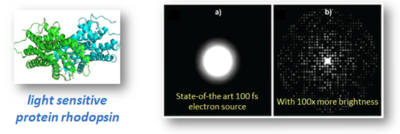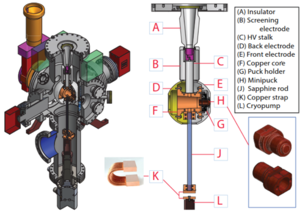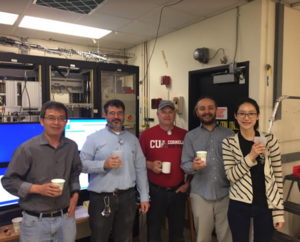CLASSE NEWS |
22 Jun 2017
Towards a Molecular Movie for Biological Processes

Simulated diffraction patterns of a rhodopsin protein crystal with an (a) state-of-the-art electron source, and (b) a source capable of 100x better brightness.
Electron diffraction has become a valuable measurement technique, with modern ultrafast electron diffraction (UED) experiments now capable of atomic level observation of structural dynamics using tabletop sized setups--that is, a machine capable of a making "molecular movie", small enough to fit inside a single room. The desire for single-shot UED beam lines capable of measuring sample sizes as large as biologically-relevant protein crystals continues to push the development of new, brighter electron sources. Recent advances at CLASSE within Prof. Ivan Bazarov's research group towards the development of low mean transverse energy (MTE) photocathodes as well as high voltage gun technology promise the first step towards this type of machine.
Shortly before her dissertation defense, Prof. Bazarov's graduate student Hyeri Lee reached a major milestone of this greater effort, completing the assembly and initial testing of the world's first cryogenically cooled high voltage dc electron source. This new type of electron gun combines the group's recent advances in novel photocathode materials operated at low temperatures with a gun that can provide the necessary high electric field and voltage to be a next-generation UED source. By cryogenically cooling the gun, the electrons are emitted with a much smaller spread in energy, dramatically reducing the "blur" in ultrafast electron diffraction experiments. Simulations predict up to a factor of 100 improvement in this blurriness using this type of machine, compared with the current state-of-the-art (figure 1).
More work will continue in Cornell's Center for Bright Beams, when this gun is reassembled in the center's new location in Newman hall, then connected with diagnostics to verify its predicted capability for electron diffraction.

Design of the world's first cryogenically cooled dc electron gun.

Researchers Xianghong Liu, Luca Cultrera, Tobey Moore, Ivan Bazarov, and Hyeri Lee.



